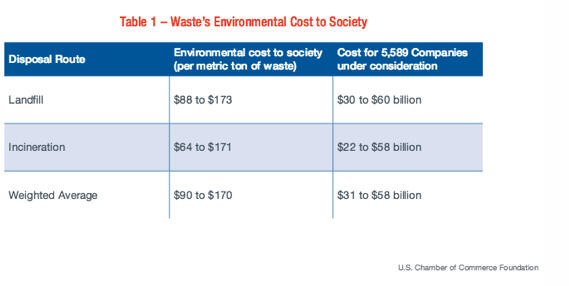 |
| Reviews and Templates for Expression We |
How Walmart, IBM, Change Waste Streams to Profit Streams

If the 5,589 largest publicly traded companies in the US reduced their paper waste by a mere 1 percent, it would save them nearly $1 billion in total, according to the US Chamber of Commerce Foundation.
A new study by the Foundation — the US Chamber’s research arm — says these same companies sent 342 million metric tons of waste to landfills and incinerators in 2014. And on average, companies generate 7.81 metric tons of waste for every million dollars in revenue.
The report, Trash to Treasure: Changing Waste Streams to Profits Streams, says companies are not accurately estimating, measuring and managing their waste streams, which means they are throwing away huge opportunities for profit and increased efficiency.
The short-term solution, says Jennifer Gerholdt, director of Environmental Initiatives for the Foundation’s Corporate Citizenship Center, is to better measure their waste and to learn how to monetize it. Long-term, Gerholdt suggests moving towards closed-loop manufacturing processes.
“One of the most viable and attractive opportunities for companies to eradicated waste and generate revenue is by adopting a circular economy,” Gerholdt said in an interview. “The circular economy could unlock an additional $4.5 trillion in economic growth by 2030,” she adds, citing a book published last year by Accenture.
Gerholdt points to Walmart and IBM — two of the firms highlighted in the report — as examples of companies that have identified waste as an issue and are working to reduce it.
Walmart tracks data across 50 separate waste categories and uses that information to increase efficiency and reduce waste. One such program was Walmart’s internal food waste and damage reduction campaign that helped the retailer keep about 30 millions pounds of food from becoming waste in 2014. Some of it stayed on shelves because of more efficient production processes; some was donated. Through this and its other waste management efforts, Walmart has reached an 82.4 percent waste diversion rate across its US operations.
IBM focuses on reuse and product stewardship. The company’s end-of-life management operations in 2014 processed 32,000 metric tons of products — that’s 97 percent of the end-of-life products it collected for processing that year. Of those, IBM recycled 54.9 percent, refurbished and resold 34.9 percent, reused 6.8 percent, sent 2.9 percent to waste-to-energy programs, and only sent 0.5 percent to landfills.
This same year, IBM reduced its packaging by about 101.6 metric tons through product and packaging redesign, saving the company $2 million in material and transportation costs.
Report author Lawrence Bowdish says an immediate step companies can take is to look at what they throw away. “A lot of this has to do with assessment and data tracking,” Bowdish said in an interview. Waste management and recycling company Republic Services offers a service called Blue Print Waste Assessment to help firms do this. “That’s the first step,” Bowdish says. “Then figure out what to go after, such as paper and plastics.”
|
Copyright remains with the original authors |